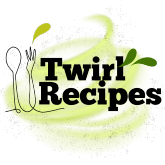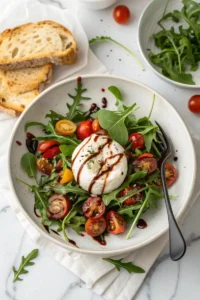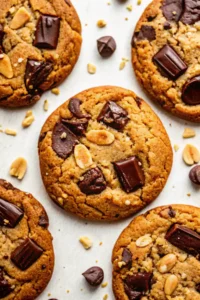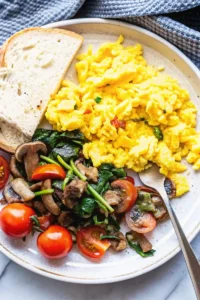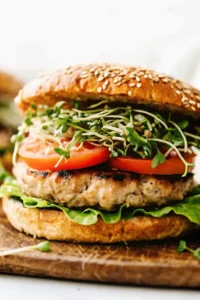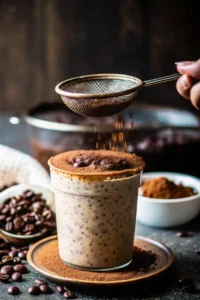Is there anything better than warm, flaky biscuits that everyone can enjoy? For those who follow a gluten-free lifestyle, the joy of biting into a tender, buttery biscuit may feel like a distant dream—but not anymore! Gluten-free biscuits are here to change the game, offering the same mouthwatering flavor and texture without the gluten. Whether you’re managing celiac disease, gluten intolerance, or simply exploring gluten-free options, these biscuits promise to bring comfort back to your plate. Let’s discover why they’ve become a beloved choice for so many.
JUMP TO
Why You’ll Love Gluten-Free Biscuits
Why Gluten-Free Is Important
For individuals with gluten sensitivities or celiac disease, traditional wheat-based biscuits can cause more harm than good. Gluten—a protein found in wheat, barley, and rye—triggers adverse reactions, from digestive issues to fatigue. Enter gluten-free biscuits, a delightful alternative that eliminates these risks while still delivering on flavor. Choosing gluten-free options not only caters to dietary needs but also allows everyone at the table to enjoy the same treats, worry-free.
Taste and Texture
Gone are the days when gluten-free meant bland or crumbly! Today’s recipes and flour blends have revolutionized gluten-free baking, creating biscuits that are just as fluffy, flaky, and buttery as the classics. Using the right balance of ingredients like almond flour or tapioca starch ensures these biscuits retain the perfect structure and mouthfeel. Whether topped with jam, honey, or savory butter, their melt-in-your-mouth quality will make them a household favorite.
Versatility for Every Meal
One of the best things about gluten-free biscuits is how versatile they are. Serve them with a hearty soup for dinner, as the base of a breakfast sandwich, or alongside a comforting casserole.
Health Benefits of Gluten-Free Biscuits
Reduced Inflammation
Did you know that opting for gluten-free biscuits can help reduce inflammation in those sensitive to gluten? Gluten triggers an immune response in people with celiac disease or gluten intolerance, leading to discomfort, bloating, and even long-term damage to the intestines. By switching to these biscuits, you can enjoy a delicious treat while supporting your body’s well-being. Plus, gluten-free options are often gentler on digestion, making them a great choice for anyone seeking to feel their best.
Easily Digestible Ingredients
Thanks to ingredients like rice flour, almond flour, and tapioca starch, gluten-free biscuits are easier on the stomach than their wheat-based counterparts. These alternatives lack the complex proteins found in gluten that can be hard to break down. This makes gluten-free baking an excellent option for those with sensitive stomachs or anyone looking to simplify their diet without giving up indulgent baked goods.
Customizable for Healthier Choices
What’s even better? Gluten-free biscuits are incredibly flexible when it comes to ingredients. You can experiment with healthier alternatives like coconut oil or flaxseed meal to suit your dietary goals. Want a lower-carb option? Swap out some starch for almond flour. Craving an extra boost of fiber? Oat flour is a fantastic addition. The ability to tailor these biscuits to your needs means you can enjoy a nutritious, satisfying treat without compromise.
For even more inspiration, check out our guide on substitutes for heavy cream to make your biscuits even lighter and dairy-free if needed!
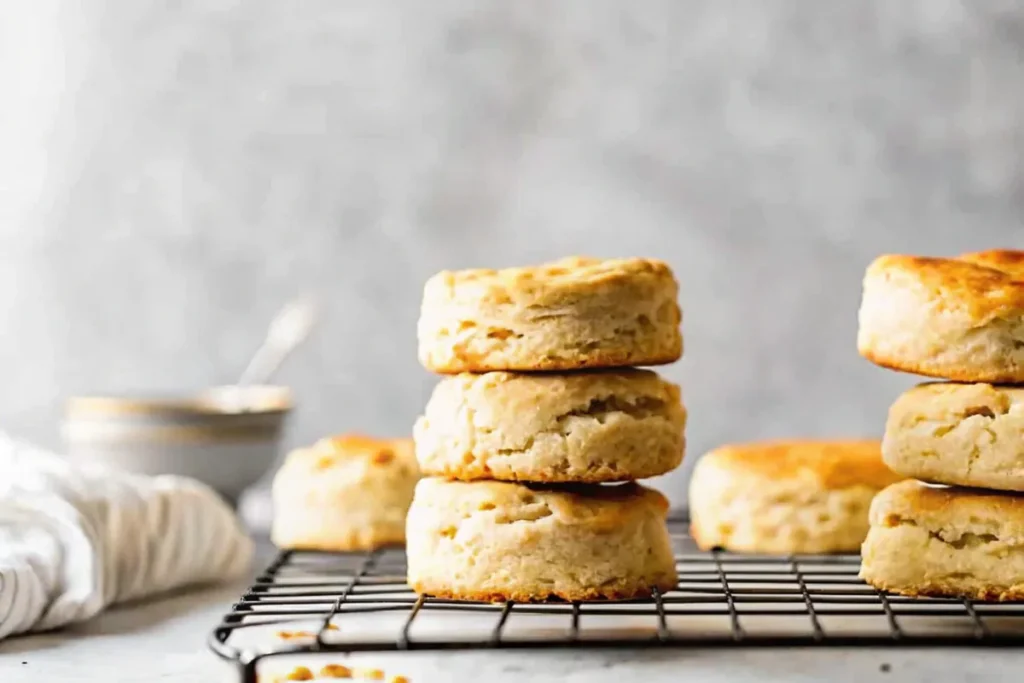
Ingredients for Gluten-Free Biscuits
Here’s a detailed list of ingredients to make a batch of soft, flaky gluten-free biscuits. This recipe serves 6-8 biscuits depending on size.
Dry Ingredients
- 2 cups gluten-free all-purpose flour blend (make sure it includes xanthan gum; if not, add 1 teaspoon separately)
- 1 tablespoon baking powder (ensures a good rise)
- ½ teaspoon baking soda (optional, for extra fluffiness)
- ½ teaspoon salt (balances the flavors)
- 1 tablespoon sugar (optional, for a hint of sweetness)
Wet Ingredients
- 6 tablespoons cold unsalted butter (cubed; substitute with coconut oil or a vegan butter alternative for dairy-free)
- ¾ cup buttermilk (for tangy flavor and tenderness; substitute with a mixture of almond milk and 1 teaspoon of vinegar for dairy-free)
Optional Add-Ins
- 1 tablespoon chopped fresh herbs (e.g., rosemary, thyme, or chives for a savory twist)
- ¼ cup shredded cheese (like cheddar or parmesan for cheesy biscuits)
- 1 tablespoon honey or maple syrup (for a subtle sweetness in the dough)
For Topping
- 1 tablespoon melted butter (brushed on top for a golden finish; use dairy-free alternatives as needed)
- Sprinkle of coarse salt or garlic powder (optional, for extra flavor)
How to Make Gluten-Free Biscuits
1- Prepare Your Ingredients
Before you begin, make sure all your ingredients are ready and measured. Preheat your oven to 425°F (220°C) and line a baking sheet with parchment paper. If you’re using butter, ensure it’s chilled, as cold butter is key to flaky biscuits. If you’re using a dairy-free substitute, refrigerate it beforehand.
2- Mix the Dry Ingredients
In a large mixing bowl, whisk together gluten-free flour, baking powder, baking soda, salt, and sugar. This ensures the leavening agents are evenly distributed, giving your biscuits a uniform rise.
3- Cut in the Butter
Add the cold, cubed butter to the dry mixture. Use a pastry cutter, two forks, or your fingers to break down the butter until the mixture resembles coarse crumbs. The small chunks of butter will melt during baking, creating tender, flaky layers.
4- Add the Wet Ingredients
Pour the buttermilk (or dairy-free alternative) into the mixture. Stir gently with a wooden spoon or spatula until the dough comes together. The dough will be sticky—this is normal! Avoid overmixing, as it can make the biscuits tough.
5- Shape the Dough
Lightly dust a clean surface with gluten-free flour. Turn the dough out and gently pat it into a rectangle about 1-inch thick. Fold the dough over itself 2-3 times to create layers, which helps with flakiness. Use a round biscuit cutter or the rim of a glass to cut out biscuits. Press straight down without twisting to maintain even edges.
6- Bake to Perfection
Place the biscuits on the prepared baking sheet, leaving about 1 inch of space between them. Brush the tops with melted butter for a golden finish. Bake for 12-15 minutes or until the tops are lightly browned and the biscuits have risen beautifully.
7- Serve and Enjoy
Let the biscuits cool slightly before serving. They’re best enjoyed warm, paired with your favorite toppings like honey, jam, or savory spreads. These biscuits also freeze well, so you can enjoy them anytime.
Tips for the Best Gluten-Free Biscuits
Secret to Fluffiness
The secret to achieving fluffy gluten-free biscuits lies in the temperature of your ingredients and how you handle the dough. Always use cold butter or a chilled substitute, as this helps create steam pockets during baking, resulting in a tender, airy texture. Additionally, avoid overworking the dough—gluten-free flours don’t have the elasticity of wheat, so overmixing can lead to dense, heavy biscuits.
Choosing the Right Gluten-Free Flour Blend
Not all gluten-free flour blends are created equal. Look for a blend specifically designed for baking that includes xanthan gum or guar gum, which mimic the binding properties of gluten. For a more homemade touch, you can create your own blend using rice flour, potato starch, and tapioca flour. Adding a bit of almond or oat flour can also enhance the flavor and nutritional value of your biscuits.
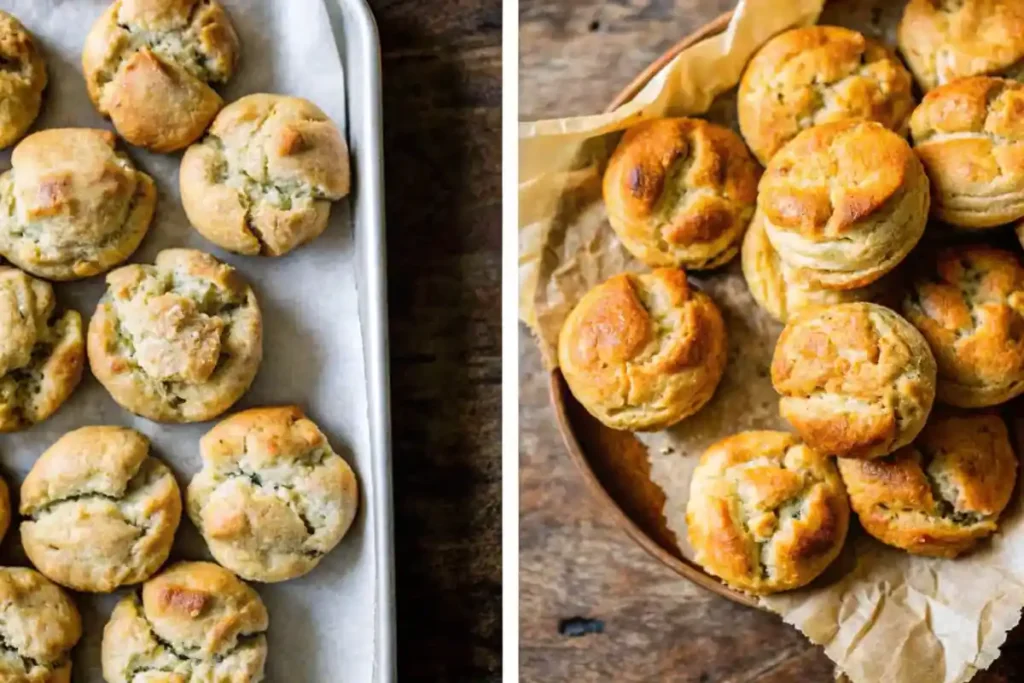
Avoid Over-Baking
To achieve that perfectly golden top without drying out the center, keep an eye on your biscuits as they bake. Start checking them around the 12-minute mark. They should look golden on top and slightly firm to the touch. Over-baking can lead to dry, crumbly biscuits, so err on the side of caution!
Experiment with Add-Ins
Gluten-free biscuits are wonderfully adaptable. For a savory spin, mix in shredded cheese, garlic powder, or fresh herbs like rosemary or thyme. If you prefer sweet treats, a pinch of cinnamon or a handful of chocolate chips can transform these biscuits into a dessert-like delight.
Storage and Freezing Instructions
Best Way to Store Gluten-Free Biscuits
Freshly baked gluten-free biscuits are best enjoyed warm, but you can store leftovers to keep them delicious for later. Place cooled biscuits in an airtight container or a resealable bag. At room temperature, they’ll stay fresh for up to two days. If you want to extend their shelf life, refrigerate them—they’ll last up to a week. For optimal freshness, reheat refrigerated biscuits in the oven at 350°F (175°C) for 5-7 minutes.
Freezing Tips for Gluten-Free Biscuits
Gluten-free biscuits freeze wonderfully, whether raw or baked! To freeze unbaked biscuits, place them on a baking sheet lined with parchment paper and freeze until solid. Once frozen, transfer them to a resealable freezer bag or airtight container. When you’re ready to bake, pop them straight into the oven without thawing—just add a few extra minutes to the baking time.
For baked biscuits, let them cool completely before freezing. Wrap each biscuit in plastic wrap or foil to prevent freezer burn, then store them in a freezer-safe bag. To reheat, thaw at room temperature or warm them in the oven for 10 minutes.
Reheating for That Freshly Baked Taste
To bring back that just-baked flavor, always reheat biscuits in an oven or toaster oven rather than a microwave. A quick brush of melted butter before reheating can also enhance their texture and flavor.
Whether for quick breakfasts or last-minute dinners, having gluten-free biscuits ready in the freezer ensures you’ll always have a comforting treat on hand. If you love these make-ahead ideas, check out our sourdough cinnamon rolls—another freezer-friendly favorite!
Creative Variations and Recipes for Gluten-Free Biscuits
Sweet Biscuits
Transform your gluten-free biscuits into a delightful dessert by adding a touch of sweetness. Stir in a tablespoon of honey, maple syrup, or a pinch of cinnamon to the dough. For an indulgent treat, fold in chocolate chips or dried fruits like cranberries or raisins. These sweet biscuits are perfect for pairing with whipped cream and fresh berries to make a gluten-free shortcake dessert.
Savory Additions
Take your biscuits to the next level with savory flavors. Mix in shredded cheddar, parmesan, or even pepper jack cheese for a cheesy biscuit that’s irresistible. Enhance the flavor further with fresh herbs like rosemary, thyme, or chives. Garlic powder or a sprinkle of smoked paprika can add an extra punch of flavor, making these biscuits an excellent side for soups and stews.
Breakfast Biscuit Sandwiches
Turn your gluten-free biscuits into a hearty breakfast by using them as the base for a sandwich. Layer them with scrambled eggs, sausage patties, or a slice of cheddar for a morning meal that’s as delicious as it is satisfying. For a lighter option, pair them with avocado slices and a poached egg.
Customizable Flours for Unique Textures
If you’re feeling adventurous, experiment with different flour blends. Use almond or coconut flour for a slightly sweet, nutty flavor or oat flour for a heartier texture. Each variation brings a unique twist to your gluten-free biscuits, making them truly your own.
For more creative breakfast ideas, explore our sourdough breakfast recipes—they’re sure to inspire! Whether sweet or savory, these biscuits prove that gluten-free doesn’t mean giving up on flavor or creativity.
Frequently Asked Questions
What flour is gluten-free?
There are several gluten-free flours that work wonderfully in baking. Popular options include almond flour, coconut flour, rice flour, and blends specifically designed for gluten-free recipes. Tapioca starch and potato starch are often included in mixes to provide structure and a light texture, making them ideal for creating fluffy biscuits.
Can you get gluten-free pancake mix?
Absolutely! Many brands offer gluten-free pancake mixes that can also be used to make biscuits, waffles, and other baked goods. Look for mixes labeled “certified gluten-free” to ensure no cross-contamination. These mixes often include blends of rice flour, potato starch, and xanthan gum, making them versatile for quick and easy baking.
Why is everyone going gluten-free?
The popularity of gluten-free diets stems from the growing awareness of gluten sensitivities, celiac disease, and the desire for healthier eating habits. While some people avoid gluten for medical reasons, others find that cutting gluten improves digestion, reduces bloating, and increases energy. However, it’s important to note that a gluten-free diet is only necessary for those with gluten-related health issues.
Can biscuits be made in an air fryer?
Yes, you can absolutely make biscuits in an air fryer! Place your gluten-free biscuit dough in the air fryer basket, leaving enough space for them to expand. Cook at 375°F (190°C) for 10-12 minutes or until they’re golden brown. Air fryers give biscuits a beautifully crisp exterior while keeping the inside tender and fluffy—a perfect option for quick, hassle-free baking!
Latest Recipes to Inspire Your Next Meal
